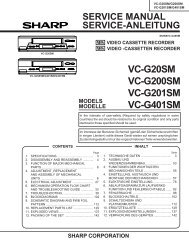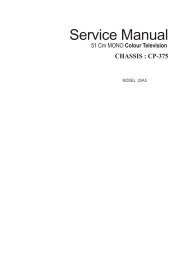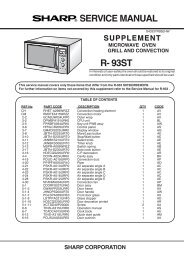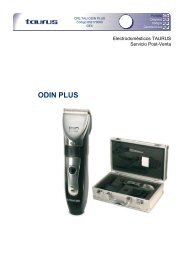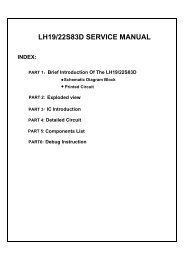You also want an ePaper? Increase the reach of your titles
YUMPU automatically turns print PDFs into web optimized ePapers that Google loves.
can always be overridden by the user after the event.<br />
Each line on the diagram, with its associated text, represents the exact conditions under which the change of state will<br />
occur. Sometimes this will be accompanied by another action which will be automatically performed by the television,<br />
being to either ENABLE or DISABLE F/SW 1.<br />
5-4-7 Over Current Protection<br />
In case of overload, the SMPS secondary voltages will drop. The voltage on pin 64 of microcontroller drops below a<br />
reference voltage (2.26V). The controlling software which continuously monitors this voltage will switch the set to<br />
stand by mode. To power on the set again the user must switch it off using the main power switch. Appropriate hysteresis<br />
guaranrees a reliable operation.<br />
5-5 Teletext Display<br />
National character option bits C12, C13, C14 are transmitted in the page header of a given teletext page. The national<br />
option bits are intended to change (or exchange) 13 characters within the G0 character set, according to the needs of<br />
each national language. However, for Cyrillic and Greek languages, a major character set change (a change of character<br />
mapping) needs to effected for correct display.<br />
These codes represent, for a given broadcaster, the intended language that the teletext page should be displayed in. As<br />
there are only 3 bits, there are only 8 codes available to cover all the possible language combinations. This means that<br />
for a received code there are several possibilities meanings, and therefore several possibilities for display.<br />
This is not as bad as it first seems, as we use the user-selected OSD language to identify the intention of the broadcaster.<br />
For example, a user wishing to see Russian teletext should select Russian OSD language, otherwise he would not have<br />
correct teletext display on the TV.<br />
The table below allows the reader to understand the relationship between selected OSD language (which is under user<br />
control), the teletext language display (selected by national option bits in transmission page header) and the language<br />
mapping (either Latin or Greek/Cyrillic)<br />
An example: For Greek teletext display, (if national option code 1 1 1 is received from the broadcaster), the user should<br />
select the Greek OSD language. Even if English, French, German, Italian, Spanish, Dutch, Danish, Finnish, Norwegian<br />
or Swedish OSD languages are selected, the teletext will be correctly displayed.<br />
However, if Polish, Hungarian, Czech, Slovakian, Rumanian or Russian OSD are selected, Latin font mapping is<br />
selected. The consequence will be incorrect teletext display, with NO GREEK CHARACTERS DISPLAYED. Romanian<br />
national font options will be selected.<br />
- 51 -



